An Experimental Study of a Novel System Used for Cooling the Protection Helmet
Abstract
:1. Introduction
2. Materials and Methods
2.1. Working Principles and Operating Procedure
- A water supply bottle which holds water used to moisten the helmet cover and is equipped with a hand pump that allows pushing the water towards the reservoir at the top of the helmet.
- A flexible plastic tube where part of it is used to deliver water from the bottle to the water reservoir on top of the cover and the other part is perforated to allow distribution of the water in such a way that the cover is uniformly moistened.
- A small water tank on top of the helmet holds water that will be distributed over the helmet cover.
- The helmet cover is the main part that provides a large surface area for the evaporation process and is made of canvas with a high absorption capacity to hold the water used in the evaporation process.
- A small solar fan powered by solar energy to increase the wind speed intended to enhance the evaporation rate from the cover surface. This fan receives its energy from the solar panel and delivers air at a speed of around 2.3 m/s.
2.2. Experimental Setup and Measuring Devices
3. Mathematical Modeling
3.1. Heat Transfer Rates
3.1.1. Heat Transfer Rate by Conduction
3.1.2. Heat Transfer Rate by Convection
3.1.3. Heat Transfer Rate by Radiation
3.1.4. Heat Transfer Rate by Evaporation
3.2. The Amount of Water Required during the Operating Period
4. Results and Discussion
4.1. Variations of the Temperature of the Inner Surface of the Helmet with Various Parameters
4.2. Variations of the Temperature of the Outer Surface of the Helmet with Various Parameters
4.3. The Differences between the Outer and the Inner Surface Temperatures in the Three Cases
4.4. The Effect of the Fan Addition on the Mass Transfer Coefficient and Evaporation Rate
4.5. The Variation in the Total Heat Transfer Rates with Respect to Time in the Three Cases
4.6. The Difference between the Rates of Heat Transfer by Different Mechanisms, Convection, Radiation, and Evaporation in the Case of the Ventilated Wet Helmet
4.7. Spread of Data with Respect to the Central Values
4.8. Model Validation
5. Conclusions
- The proposed system is characterized by ease of implementation and free power consumption.
- By covering the helmet with a wet canvas, both the temperatures of the outer and the inner surfaces dropped by about 9 degrees with respect to the dry uncovered helmet. The addition of the solar fan helped in a further drop of the temperatures of about 5 degrees.
- Both the outer and the inner surface temperatures were characterized by a good level of stability with ranges of temperatures that are compatible with human comfort conditions.
- In the cases of wet and ventilated wet helmets, the inner surface temperature is higher than the outer surface temperature, so the heat flow is directed from the inside to the outside and works to release the heat produced by the human head.
- The addition of the fan led to increased stability in the values of the mass transfer coefficient and evaporation rate.
- There was an increase in the cooling rate equivalent to 63.3% when adding the wet cover, and an increase of up to 131.7% when adding the fan with the wet cover.
- In the case of the ventilated wet helmet the rate of heat transfer by evaporation was higher than that by convection by 1.82 times and higher than that by radiation by 13.72 times.
- Heat transfer in the case of evaporation always goes outside to contribute to the cooling process, while heat transfer by convection and radiation fluctuates in and out according to the differences in temperature values.
- The proposed system can be developed to include an automatic water distribution system to improve performance, and it can be driven by solar energy to maintain the advantage of being power free.
Author Contributions
Funding
Data Availability Statement
Conflicts of Interest
Nomenclature
| Area, (m2) | |
| Diameter, (m) | |
| Mass diffusivity of water vapor in the air, (m2/s) | |
| Heat transfer coefficient, (W/m2·K) | |
| Latent heat of vaporization, (kJ/kg) | |
| Mass transfer coefficient, (m/s) | |
| Thermal conductivity, (W/m·K) | |
| Evaporation rate, (kg/s) | |
| Mass, (kg) | |
| Nusselt number | |
| Prandtl number | |
| Pressures, (kPa) | |
| Heat transfer rate, (W) | |
| Reynolds number | |
| Vapor gas constant, (kJ/kg·K) | |
| Schmidt number | |
| Sherwood number | |
| Time, (s) | |
| Temperature, (°C or K) | |
| Helmet shell thickness | |
| Container volume, (mL) | |
| Air velocity, (m/s) | |
| Subscripts | |
| Ambient | |
| Air | |
| Atmospheric | |
| Average | |
| Conduction | |
| Convection | |
| Dry air | |
| Evaporation | |
| High-density polyethylene | |
| Heat | |
| Inner surface | |
| Outer surface | |
| Radiation | |
| Surface | |
| Saturation | |
| Surroundings | |
| Total | |
| Vapor | |
| Water | |
| Greek letters | |
| Emissivity | |
| Dynamic viscosity, (kg/m·s) | |
| Kinematic viscosity, (m2/s) | |
| Density, (kg/m3) | |
| Stefan–Boltzmann constant, (W/m2K4) | |
| Relative humidity |
References
- Van Hoof, J.; Mazej, M.; Hensen, J.L.M. Thermal comfort: Research and practice. Front. Biosci. Landmark 2010, 15, 765–788. [Google Scholar] [CrossRef] [PubMed]
- Kaushik, A.; Arif, M.; Tumula, P.; Ebohon, O.J. Effect of thermal comfort on occupant productivity in office buildings: Response surface analysis. Build. Environ. 2020, 180, 107021. [Google Scholar] [CrossRef]
- Davis, G.A.; Edmisten, E.D.; Thomas, R.E.; Rummer, R.B.; Pascoe, D.D. Effects of ventilated safety helmets in a hot environment. Int. J. Ind. Ergon. 2001, 27, 321–329. [Google Scholar] [CrossRef]
- Cao, Y.; Lei, T.H.; Wang, F.; Yang, B.; Mündel, T. Head, Face and Neck Cooling as Per-cooling (Cooling during Exercise) Modalities to Improve Exercise Performance in the Heat: A Narrative Review and Practical Applications. Sports Med. Open 2022, 8, 1–17. [Google Scholar] [CrossRef] [PubMed]
- Zambrano-Becerra, S.F.; Galvis-Sanchez, P.M.; Perez-Rangel, N.Y.; Florez-Solano, E.; Espinel-Blanco, E. Development of an integrated cooling system for motorcycle helmet by physical study of temperature variations and heat transfer. J. Phys. Conf. Ser. 2022, 2153, 012010. [Google Scholar] [CrossRef]
- Vijayrakesh, K.; Muthuvel, S.; Sivanamachivayam, G.; Yogeshwaran, N. Passive Cooling Application inside Helmet to Improve Ergonomics (21 December 2019). Available online: https://ssrn.com/abstract=3688975 (accessed on 10 March 2023).
- Mao, M.; Feng, C.; Pei, J.; Liu, H.; Jiang, H. A Triple-Layer Membrane with Hybrid Evaporation and Radiation for Building Cooling. Energies 2023, 16, 2750. [Google Scholar] [CrossRef]
- Lv, J.; Zhou, B.; Zhu, M.; Xi, W.; Hu, E. Experimental Study on the Performance of a Dew-Point Evaporative Cooling System with a Nanoporous Membrane. Energies 2022, 15, 2592. [Google Scholar] [CrossRef]
- Zhao, X.; Zhang, H.; Xi, X.; Liu, F.; Zhang, B. Effect of unidirectional surface roughness on heat transfer performance of spray cooling. Exp. Heat Transf. 2023, 36, 96–119. [Google Scholar] [CrossRef]
- Aamir, M.; Qiang, L.; Xun, Z.; Wang, H.; Ullah, R. Study on Ultra-fast Cooling Behaviors of Water Spray Cooled Stainless Steel Plates. Exp. Heat Transf. 2016, 29, 299–321. [Google Scholar] [CrossRef]
- Saleh, A.; Al-Nimr, M.A. Evaporative System for Water and Beverage Refrigeration in Hot Countries. J. Power Energy Part A 2007, 221, 1099–1105. [Google Scholar] [CrossRef]
- Saleh, A.; Al-Nimr, M.A. A Modified Air Jet Refrigeration System. Int. J. Heat Technol. 2006, 25, 23–27. [Google Scholar]
- Kashyap, S.; Sarkar, J.; Kumar, A. Proposal and month-wise performance evaluation of a novel dual-mode evaporative cooler. Heat Mass Transf. 2019, 55, 3523–3536. [Google Scholar] [CrossRef]
- Zhang, Y.; Zhang, L.; Meng, Q.; Feng, Y.; Chen, Y. A dynamic experimental study on the evaporative cooling performance of porous building materials. Heat Mass Transf. 2017, 53, 2651–2662. [Google Scholar] [CrossRef]
- Mott, D.R.; Khine, Y.Y.; Gary Tan, X.; Bagchi, A. Head Evaporative Cooling From Forced and Natural Convection for Two Helmet-Pad Configurations. In Proceedings of the ASME 2021 International Mechanical Engineering Congress and Exposition, Virtual, 1–5 November 2021. [Google Scholar] [CrossRef]
- Evaporative Cooling Technology Cooling Helmet Insert, for Mining & Construction. Available online: https://www.indiamart.com/proddetail/cooling-helmet-insert-15429542812.html (accessed on 10 March 2023).
- Techniche HyperKewl Evaporative Head Cooling under Safety Helmet. Available online: https://www.safety-workwear-shop.com/en/techniche-hyperkewl-evaporative-head-cooling-under.html (accessed on 10 March 2023).
- Hard Hat Evaporative Cooling Pads. Available online: https://www.mdsassociates.com/catalog/p-104596/pip-ez-cool-hard-hat-evaporative-cooling-pads (accessed on 10 March 2023).
- Cengel, Y.A.; Ghajar, A.J. Heat and Mass Transfer: Fundamentals and Applications, 5th ed.; McGraw-Hill Education: New York, NY, USA, 2015. [Google Scholar]
- Hu, M.; Yu, D.; Wei, J. Thermal conductivity determination of small polymer samples by differential scanning calorimetry. Polym. Test. 2007, 26, 333–337. [Google Scholar] [CrossRef]
- Okada, T.; Ishige, R.; Ando, S. Analysis of thermal radiation properties of polyimide and polymeric materials based on ATR-IR spectroscopy. J. Photopolym. Sci. Technol. 2016, 29, 251–254. [Google Scholar] [CrossRef]
- Reischl, U.; Pace, K.; Colby, C.; Goonitelleke, R. Cooling Dynamics of Wet Clothing. In Advances in Physical Ergonomics and Human Factors. Advances in Intelligent Systems and Computing; Goonetilleke, R., Karwowski, W., Eds.; Springer: Cham, The Netherlands, 2016; Volume 489. [Google Scholar] [CrossRef]

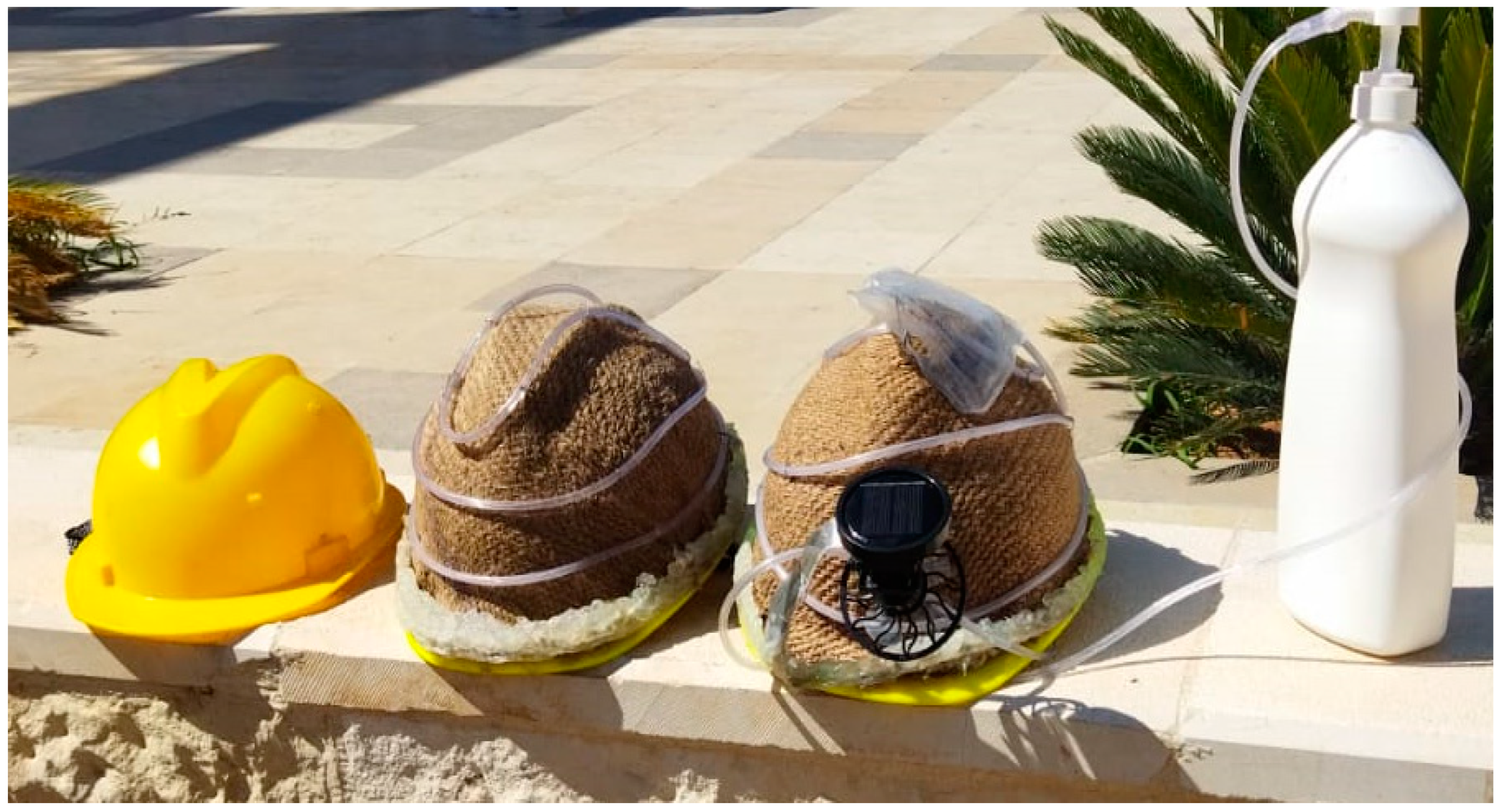

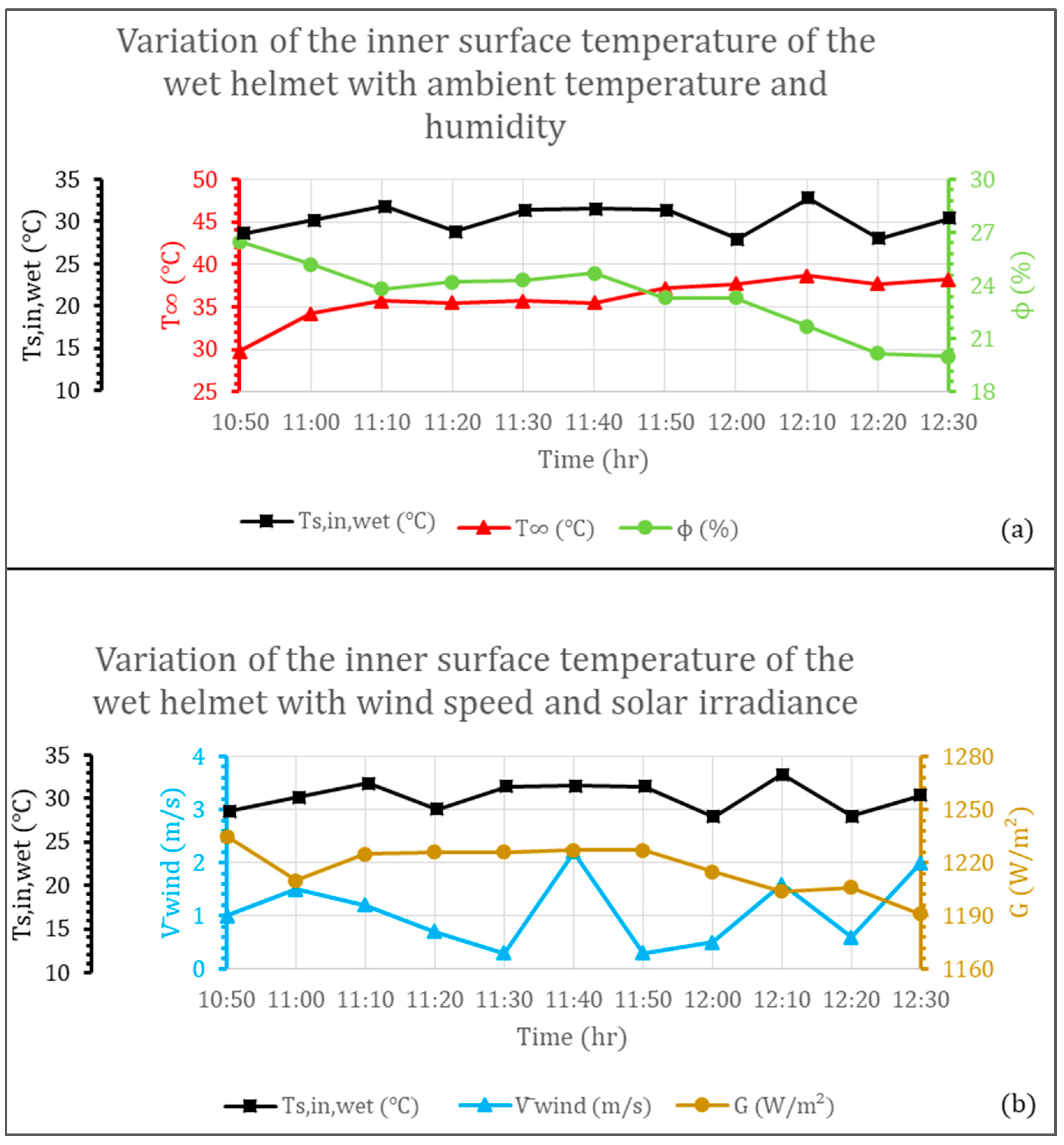


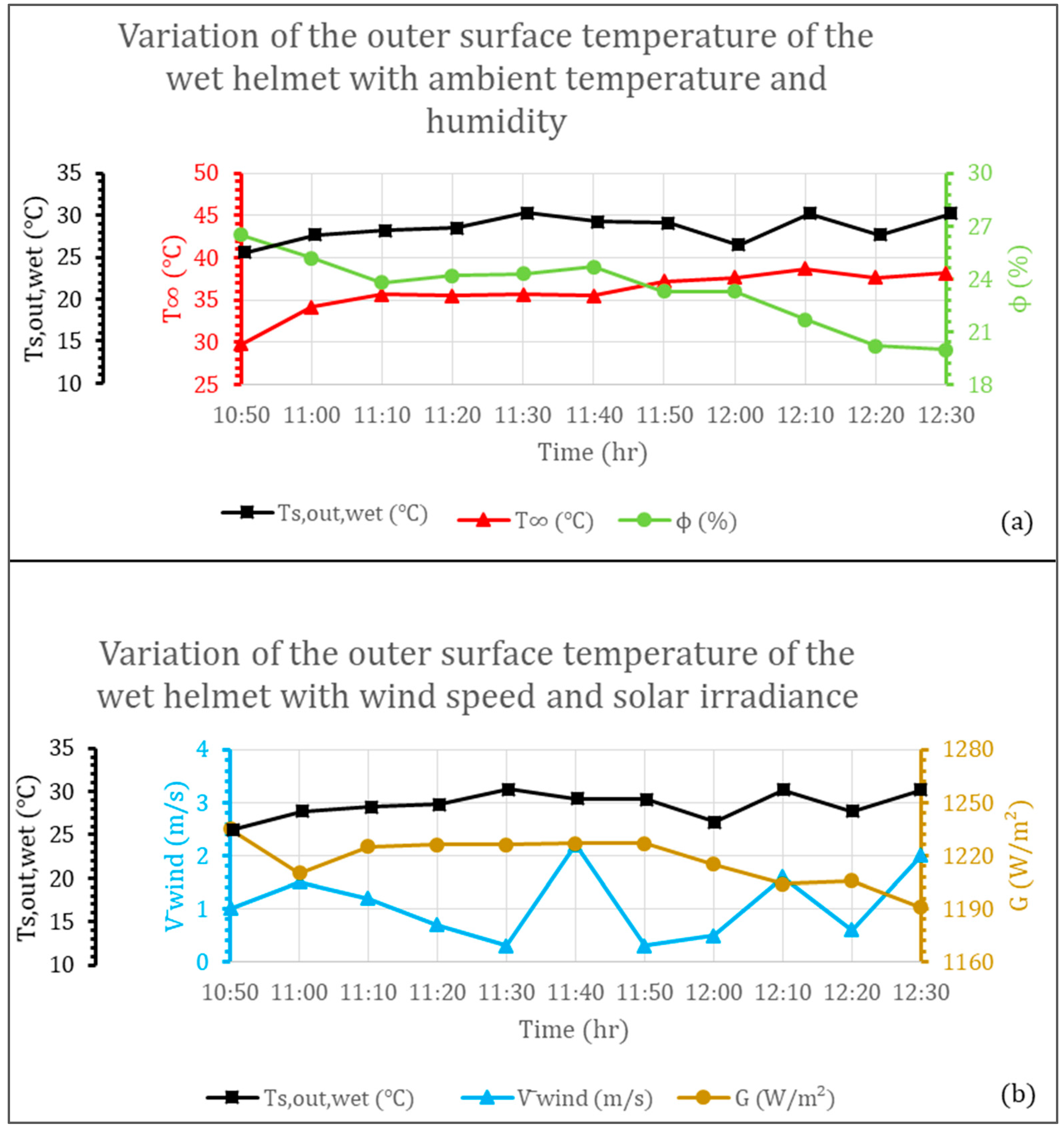

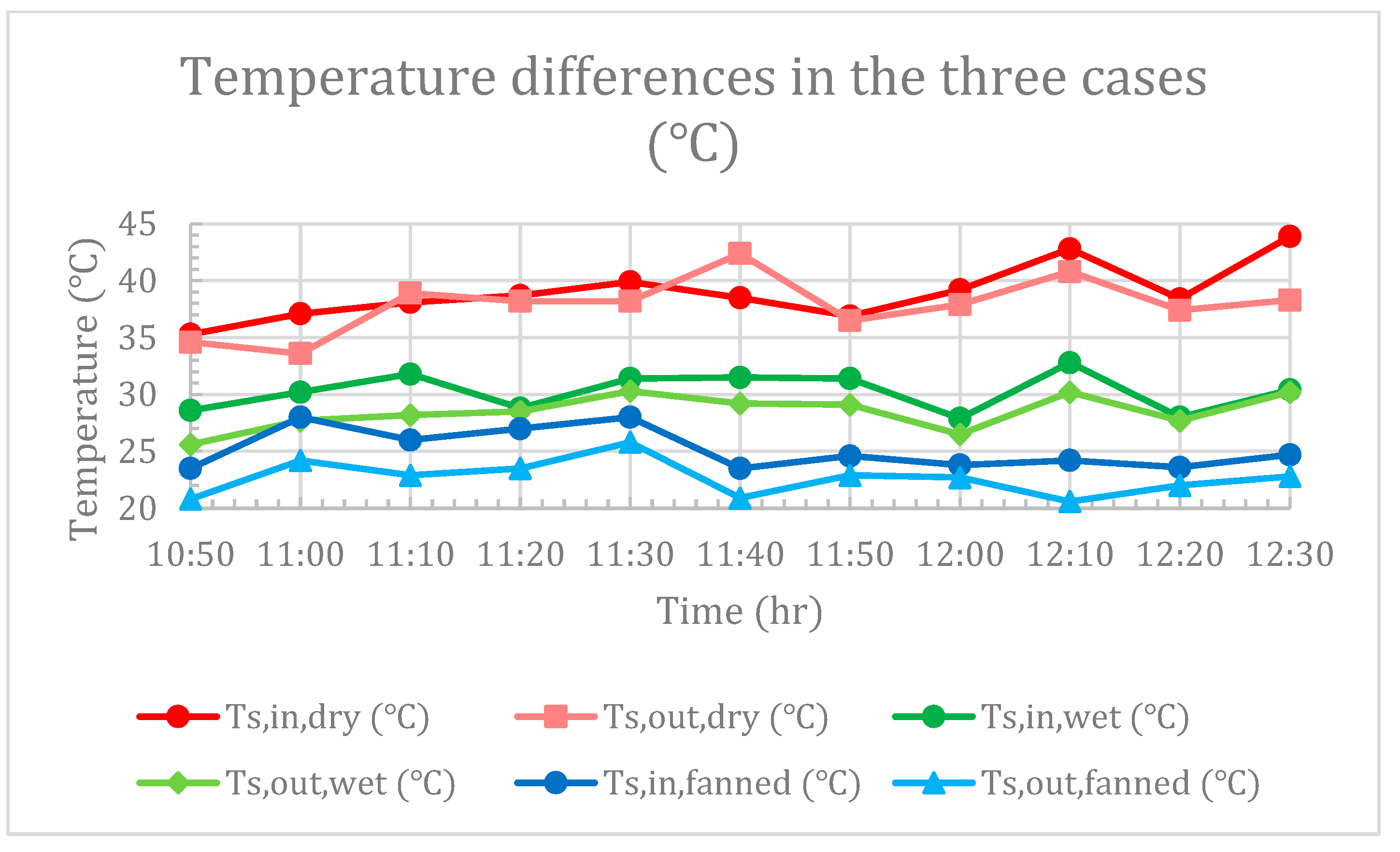
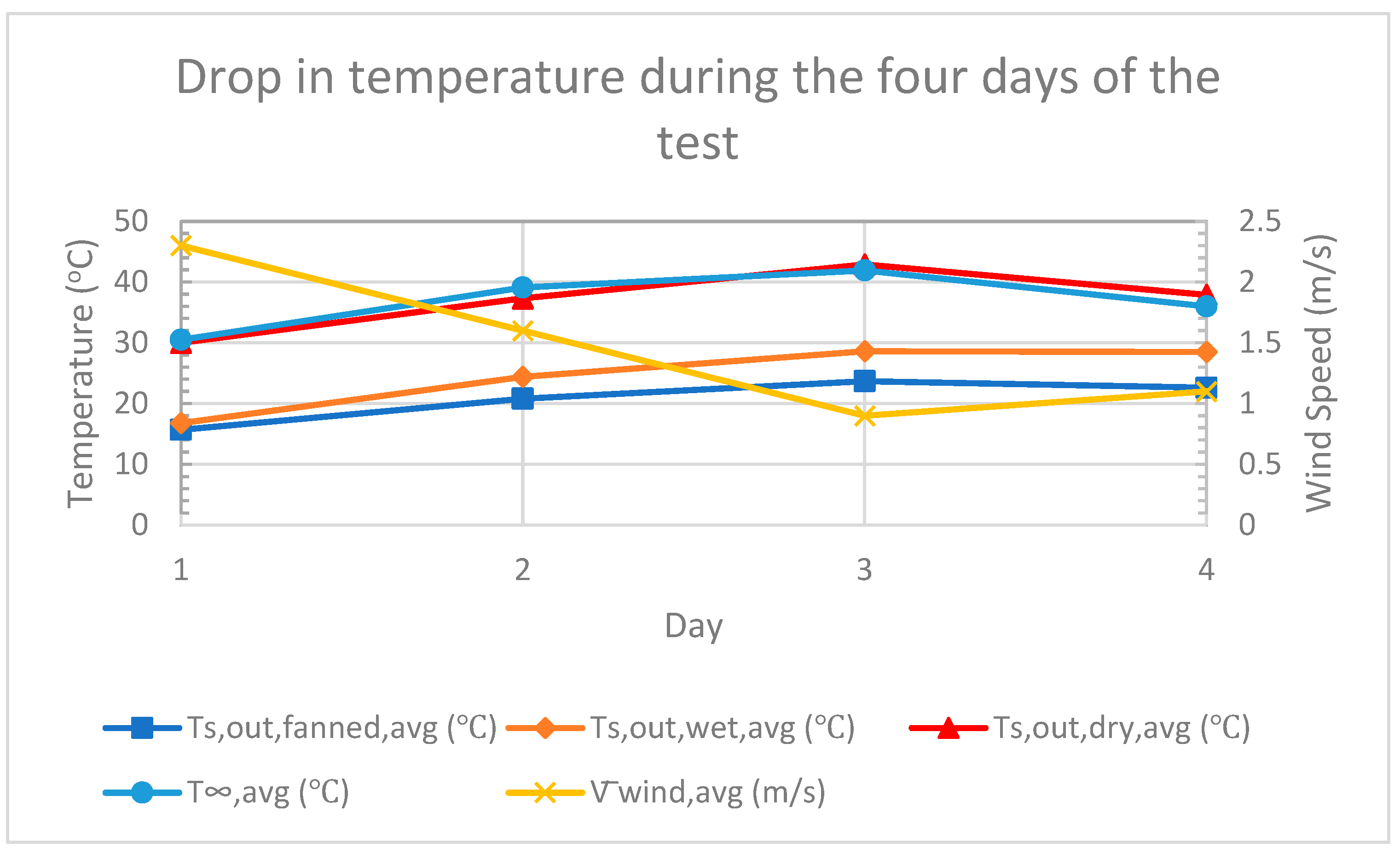
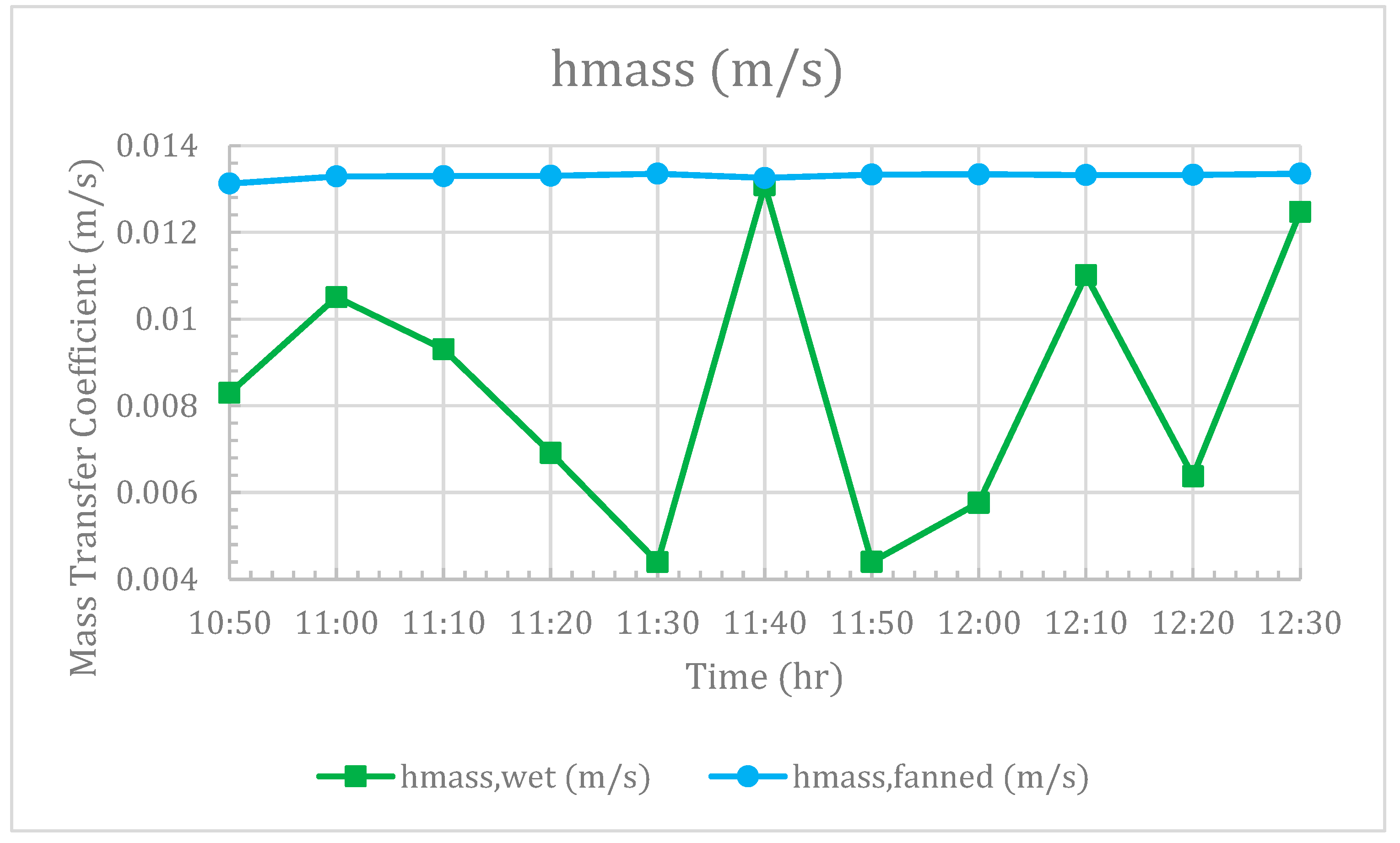



| Device | Parameter | Range | Resolution | Accuracy |
|---|---|---|---|---|
| MS6252B Anemometer | Ambient Temperature | −10~60 °C | 0.1 °C | ±1.5 °C |
| Wind Velocity | 0.80~30.00 m/s | 0.01 m/s | ±2.0% | |
| Relative Humidity | 20~80% | 0.1% | ±3.0% | |
| Infrared Thermometer DT-8220 | Outer Surface Temperature | −50~220 °C | 0.1 °C | ±2% |
| Digital LCD Temperature Thermometer | Inner Surface Temperature | −50–+70 °C | 0.1 °C | ±1 °C |
| Tm-207 solar power meter | Solar Intensity | 0–1999 W/m2 | 1 W/m2 | ±10 W/m2 or ±5% whichever is greater in sunlight |
| Parameter | Average | Mean Deviation |
|---|---|---|
| T∞ (°C) | 36 | 1.7 |
| G (W/m2) | 1217.5 | 11.1 |
| Vwind (m/s) | 1.1 | 0.6 |
| Vfan (m/s) | 2.3 | 0 |
| ϕ (%) | 23.4 | 1.5 |
| Ts,in,fanned (°C) | 25.2 | 1.5 |
| Ts,out,fanned (°C) | 22.6 | 1.2 |
| Ts,in,wet (°C) | 30.3 | 1.4 |
| Ts,out,wet (°C) | 28.5 | 1.2 |
| Ts,in,dry (°C) | 39 | 1.8 |
| Ts,out,dry (°C) | 37.9 | 1.7 |
| Exposure Time (min) | Cotton Sample (Moist) (°C) | Cotton Sample (Saturated) (°C) |
|---|---|---|
| 0.5 | 6.7 | 5.7 |
| 1.0 | 7.8 | 7.4 |
| 1.5 | 8.3 | 8.2 |
| 2 | 8.4 | 8.5 |
| 5 | 8.5 | 8.8 |
| 10 | 8.5 | 8.8 |
| 15 | 8.5 | 8.8 |
| Time (h) | Temperature of the Dry Outer Surface (°C) | Temperature of the Wet Outer Surface (°C) | Temperature Drop (°C) |
|---|---|---|---|
| 10:50 | 34.6 | 25.6 | 9 |
| 11:00 | 33.6 | 27.7 | 5.9 |
| 11:10 | 38.9 | 28.2 | 10.7 |
| 11:20 | 38.2 | 28.5 | 9.7 |
| 11:30 | 38.2 | 30.3 | 7.9 |
| 11:40 | 42.4 | 29.2 | 13.2 |
| 11:50 | 36.5 | 29.1 | 7.4 |
| 12:00 | 37.9 | 26.5 | 11.4 |
| 12:10 | 40.8 | 30.2 | 10.6 |
| 12:20 | 37.4 | 27.7 | 9.7 |
| 12:30 | 38.3 | 30.2 | 8.1 |
| Average | 37.9 | 28.5 | 9.4 |
Disclaimer/Publisher’s Note: The statements, opinions and data contained in all publications are solely those of the individual author(s) and contributor(s) and not of MDPI and/or the editor(s). MDPI and/or the editor(s) disclaim responsibility for any injury to people or property resulting from any ideas, methods, instructions or products referred to in the content. |
© 2023 by the authors. Licensee MDPI, Basel, Switzerland. This article is an open access article distributed under the terms and conditions of the Creative Commons Attribution (CC BY) license (https://creativecommons.org/licenses/by/4.0/).
Share and Cite
Saleh, A.; Kanaan, D.A. An Experimental Study of a Novel System Used for Cooling the Protection Helmet. Energies 2023, 16, 4046. https://doi.org/10.3390/en16104046
Saleh A, Kanaan DA. An Experimental Study of a Novel System Used for Cooling the Protection Helmet. Energies. 2023; 16(10):4046. https://doi.org/10.3390/en16104046
Chicago/Turabian StyleSaleh, Ahmad, and Deaa Aldeen Kanaan. 2023. "An Experimental Study of a Novel System Used for Cooling the Protection Helmet" Energies 16, no. 10: 4046. https://doi.org/10.3390/en16104046






